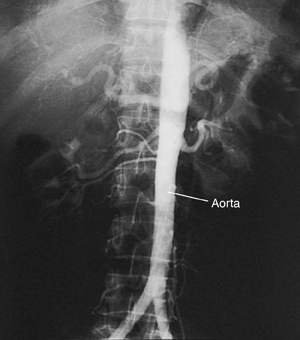Aortic Angiogram
Aortic Angiogram
An aortic angiogram is a test that takes pictures of the aorta. This is the main blood vessel that carries blood from your heart to the rest of your body. The test can show problems with your aorta, such as a blockage or an aneurysm (a balloon-like bulge in the wall of the aorta).

Before the test
Prepare for the test as you’ve been told. In addition:
-
Tell your healthcare provider if you:
-
Take any medicines. This includes over-the-counter drugs, herbal medicines and other supplements (You may need to stop taking some or all of them before the test and in some cases, for a couple of days after)
-
Are allergic or have any intolerances to any medicines, iodine, contrast fluid (dye), or if you have ever had a reaction to substances used during other imaging tests
-
Have other health problems, such as diabetes or kidney problems
-
Use tobacco or alcohol on a regular basis
-
Are pregnant or may be pregnant
-
Are breastfeeding
-
-
Follow any directions you’re given for not eating or drinking before the test
The day of the test
This test takes about 1 to 2 hours. The entire test (including time to prepare and recover) takes about 4 to 6 hours. You’ll likely go home the same day.
Before the test begins:
-
An IV line is put into a vein in your arm or hand. This line supplies fluids and medicine.
-
You’ll be given medicine (anesthesia) to keep you free of pain during the test. You may receive sedation, which makes you relaxed and sleepy. Local anesthesia is also injected into the skin to numb the area to be worked on (groin or arm).
During the test:
-
A small puncture or cut is made in the numbed skin.
-
A thin tube called a catheter is put through the puncture or cut and into a blood vessel.
-
The catheter is slowly advanced through the blood vessel and into the aorta. Live X-rays are used to help guide this process. The X-rays are viewed on a video screen.
-
Once the catheter is in the correct place, contrast fluid (dye) is sent through the catheter. X-ray pictures are then taken of the aorta. The contrast fluid (dye) makes the aorta more visible on the pictures.
-
When the test is done, the catheter is removed. Pressure is applied to the insertion site to stop any bleeding. The site is then bandaged.
After the test:
-
You’ll need to lie still for 4 to 6 hours. This lessens the chance of bleeding at the insertion site.
-
When it’s time for you to be released from the hospital, have an adult family member or friend ready to drive you home.
Recovering at home
Once at home, follow any instructions you’re given. Be sure to:
-
Drink plenty of water to help flush any remaining contrast fluid out of your body. This may take up to 24 hours.
-
Take all medicines as directed. Some medicines should not be resumed after the angiogram to prevent an interaction with the contrast dye or damage to your kidneys. Be sure to ask your healthcare team about any potential reactions.
-
Care for the catheter insertion site as directed. You may remove the bandage after 24 hours.
-
Check for signs of infection at the catheter insertion site (see below).
-
Do not bathe or shower until your bandage is removed. If you wish, you may wash with a sponge or washcloth.
-
Avoid heavy lifting or other strenuous activities as directed to prevent the site from opening and bleeding.
When to call your healthcare provider
Call your healthcare provider if you have any of the following:
-
Fever of 100.4°F (38°C) or higher, or as directed by your healthcare provider
-
Signs of allergic reaction to the contrast fluid, such as rash, nausea or vomiting, or trouble breathing
-
Signs of infection at the catheter insertion site, such as increased pain, redness, swelling, warmth, bleeding, or foul-smelling discharge
-
Coldness, tingling, or numbness in the arm or leg near the catheter insertion site
-
Rapid, pounding, or irregular heartbeat
-
Sudden pain or swelling in the legs
Follow-up care
The doctor will likely discuss initial results with you shortly after the test. A follow-up visit may also need to be scheduled.
Risks and complications
Risks and complications can include:
-
Bleeding
-
Infection
-
Blood clots
-
Damage to the aorta
-
Damage to the blood vessel used during the test
-
Abnormal heart rhythm
-
Problems due to the contrast fluid, including allergic reaction or kidney damage
-
Risks of anesthesia or any other medicines used during the test (these risks will be discussed with you before the test)
Updated:
March 16, 2019
Sources:
Endovascular repair of abdominal aortic aneurysm, Up To Date
Reviewed By:
Fetterman, Anne, RN, BSN,Sudheendra, Deepak, MD